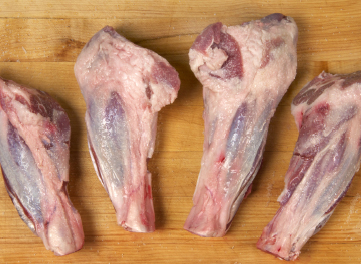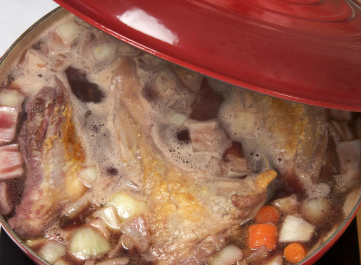THE ICON:
BRAISED LAMB SHANKS
WITH MINT GREMOLATA
JUST LOOK AT THEM! LOOK AT ALL THAT SINEW, ALL THAT connective tissue (here). Not something you can sauté. Not something you can imagine even being appetizing, what with all that bone and silverskin.
This is exactly what makes lamb shanks the quintessential meat to braise—a veritable emblem of the technique. They’re a heavily used part of the animal, making them especially tough; but that toughness, once melted, lends extraordinary depth and richness to the braising liquid. Oh-my-god richness. The deep lamb flavor intensifies and spreads throughout the braise. And shanks are typically the perfect portion size for a special meal. I used to be able to say they’re dead cheap, too, until they enjoyed a renewed popularity at restaurants beginning in the mid-1990s. I served hundreds off my station when I was a cook at the Cleveland restaurant Sans Souci; they were a great restaurant dish because they could be made ahead and reheated in the braise liquid, and any shanks that didn’t sell went to the pasta station for the next day’s ragout.
This is as straightforward as a braise gets: meat seared and slow-cooked with wine and stock and aromatic vegetables. The braising liquid is then strained and thickened to become the sauce. I chose to finish with mint, because mint goes so well with lamb. It’s a classic pairing, particularly for spring lamb, when the mint has begun to grow, but a standard parsley-based gremolata (here) would be just fine, as would a gremolata made with preserved lemon. (Be forewarned that the herbs in the gremolata will oxidize, or darken, after being cut, so it’s best to make the gremolata not too far in advance of serving it.)
The dish can be varied in numerous ways—you could use pureed tomatoes rather than stock for the liquid, and you could flavor it with curry spices, for instance.
Feel free to make more or fewer shanks depending on your needs; just be sure to add enough liquid to reach two-thirds to three-quarters of the way up the shanks. You can double the recipe and braise the shanks in a roasting pan—a great do-ahead dish for a dinner party. As ever, veal stock results in the best finished sauce—and I highly recommend it—but here, because the lamb is so flavorful, any stock of your choosing will work fine. I’d even give store-bought a try on this, though I’d cut it with an equal amount of water.
I should also note that
because of their shape, it can be difficult
to get a uniform sear on lamb shanks in
a small amount of oil, so I sear them in
plentiful oil, almost enough to pan-fry
them (see the photos here).
These lamb shanks go well with any starch—mashed potatoes, brown rice, couscous, spaetzle, egg noodles. In late fall and winter, I like to serve them on risotto. You could even put them on well-cooked wheat berries, dressed with a light lemon-mint vinaigrette. Hmm… I like this idea. I think that’s what this dish will be (see the recipe below). One of my recipe testers suggested that other vegetables would go well with the wheat berries, such as sweet potatoes and corn or, in summer, tomatoes and cucumber, both excellent suggestions for an infinitely variable salad.
4 lamb shanks
Kosher salt
Freshly ground black pepper
Flour
Vegetable oil
1 Spanish onion, sliced
2 carrots, chopped
10 garlic cloves, smashed with the flat side of a knife and then roughly chopped
4 cups/1 liter veal or chicken stock
2 cups/480 milliliters dry red wine
2 tablespoons honey
1 tablespoon Asian fish sauce
2 bay leaves
Beurre manié (here)
¼ cup/10 grams chopped fresh mint
1 tablespoon finely minced garlic
Grated zest of 1 lemon
Wheat Berry Salad (recipe follows), for serving
SERVES 4
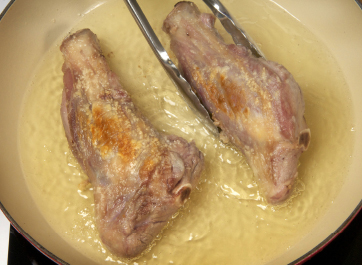
Step 2. Sear the floured shanks (because of their uneven shape, you need to use plenty of oil).

Step 3. Sauté the mirepoix (here carrot and onion) after the shanks are seared.
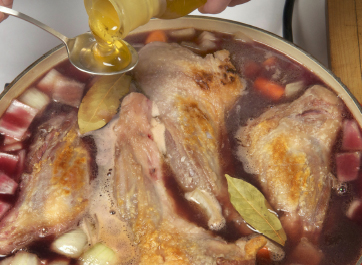
Step 4. Combine all ingredients, here finishing with a great braise addition, honey.
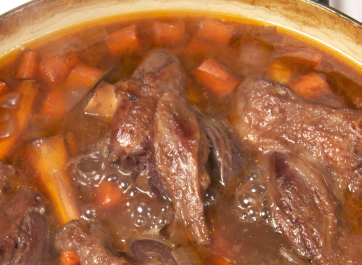
Step 6. When the shanks are cooked, remove them from the pot. Strain, defat, and return the liquid to the pot.
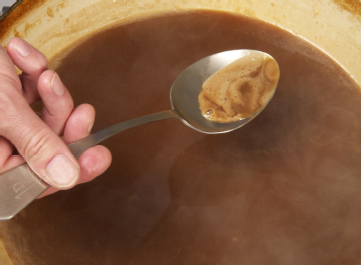
Step 7. I like to thicken this sauce with a beurre manié, and I skim any foam that rises after it has been thickened.

Step 8. Return the finished shanks to the pot to reheat in the finished sauce.
• PREHEAT your oven to 300°F/150°C.
• SEASON the lamb shanks with salt and pepper at least 10 minutes and up to 3 days before cooking them. DREDGE them in flour just before cooking; SHAKE off the excess.
• ADD plenty of vegetable oil to a Dutch oven that will comfortably contain the shanks. SEAR the shanks over medium-high heat (in batches if necessary). REMOVE them, WIPE out the Dutch oven, and RETURN it to the stovetop.
• ADD 1 tablespoon oil to your braising vessel and COOK the onion, carrots, and garlic over medium-high heat until softened, 5 to 10 minutes. RETURN the shanks to the pot and ADD the stock, wine, honey, fish sauce, and bay leaves. The shanks should be about two-thirds submerged (ADD more water, stock, or wine if necessary). BRING the liquid to a full simmer and COVER the pot. PLACE the pot in the oven and COOK until the lamb shanks are fork-tender, 2 to 3 hours.
• REMOVE the shanks from the pot. STRAIN the braising liquid through a fine-mesh sieve and REMOVE the fat that rises to the top. RETURN the defatted braising liquid to the pan, BRING it to a simmer, and THICKEN it as you wish with the beurre manié. RETURN the shanks to the pot. If you won’t be serving immediately, COVER the pot and STORE the shanks in the refrigerator for up to 5 days. REHEAT gently on the stovetop till piping hot.
• As close as possible before serving, COMBINE the mint, garlic, and lemon zest to make the mint gremolata.
• SERVE the shanks on top of the warm wheat berries, spooning the sauce over the shanks and finishing with the mint gremolata.
